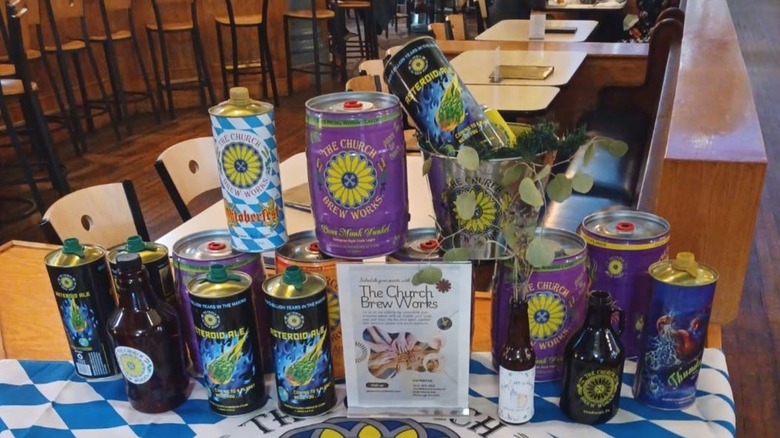The Storied Pennsylvania Brewery That Went From Church Pews To Pouring Brews
Building a brewpub inside a deconsecrated Roman Catholic church might sound unusual, if not sacrilege, but there's some significant overlap between a good bar and a good church. They both serve as a sanctuary for those who are lonely or down on their luck; they both frequently feature wood paneling; and due to the Eucharist, a Catholic sacrament which involves wine, they both even carry alcohol, although a bar offers a much more diverse menu. (We're just saying, would it kill the Catholic Church to offer a nice full-bodied Pinot Noir?) This is all to say that it makes a certain kind of sense that The Church Brew Works, one of Pittsburgh's most beloved breweries and restaurants, is located in an old Catholic church.
Before it housed The Church Brew Works, the building was known as St. John the Baptist Church, which was built and consecrated in 1902 to serve a burgeoning immigrant population in Pittsburgh. The church's gorgeous architecture, including ornate stained glass windows, a large pipe organ, and a tall bell tower, reflected its place in a growing, prosperous city. However, as deindustrialization set in and Pittsburgh's population shrank, the parish fell on hard times, and the church was eventually deconsecrated in 1993. Three years later, almost to the day, The Church Brew Works opened, restoring the church to its former beauty and establishing a thriving business.
Fine beer and food in a beautiful setting
Even if it wasn't housed inside an old church, The Church Brew Works would be a good place to eat and drink. (They'd probably have to find a new name, though.) Its food menu offers classic American fare, such as meatloaf and pulled pork sandwiches, as well as certain dishes that reflect Pittsburgh's immigrant identity — Polish pierogis, for instance, or German jagerschnitzel. As a brewpub, of course, The Church Brew Works offers an assortment of well-regarded beers, brewed in a bunch of enormous tanks that sit where the altar once sat. Some of them even have cute, thematically appropriate names, like the Pipe Organ Pale Ale and the Pious Monk Dunkel.
But boy, the setting sure doesn't hurt. The towering columns, elegant stained glass windows, and dignified wooden pews are all aesthetically pleasing in their own right, reinforcing the novelty of eating someplace where you'd previously only had Communion wafers. But together with good food, good drink, and good company, the church setting brings out the joy of coming together as a community and breaking bread. It's the same spirit as when churches come together for a Friday fish fry, or publishing potluck cookbooks in the mid-20th century. It's the kind of thing even Anthony Bourdain, who had little patience for hunting down obscure craft beers, would probably get behind.

